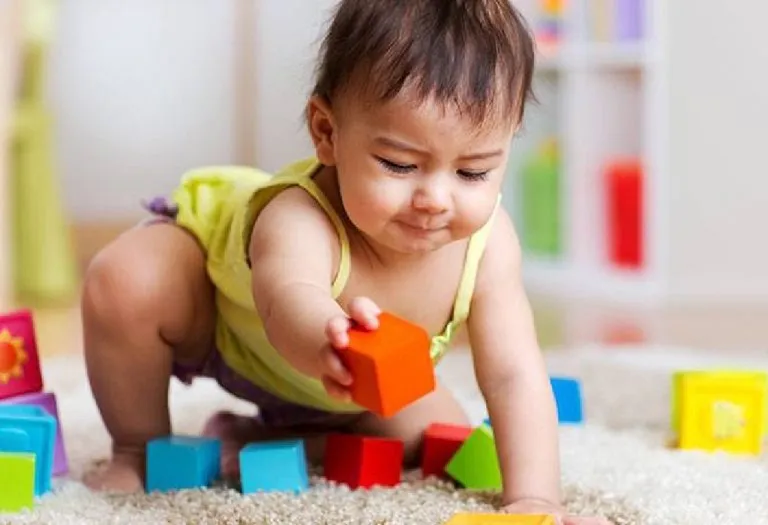How Soon Can Your Baby Play With Stacking Blocks?
Kids love to play right from the day they are born. Obviously, the variation in the kind of play they are interested in keeps changing over the days, months, and years. Playing with blocks, particularly children’s stacking blocks is one of the most important games that kids need to engage in as they grow. This simple activity fosters hand-eye coordination, spatial awareness, and fine motor skills. Many parents often wonder, “When do babies start stacking blocks?” Typically, babies start stacking blocks around 12 to 15 months of age, marking key developmental milestones in a child’s life as they begin to explore balance and problem-solving through play.
Why Are Stacking and Sorting Important?
Stacking and sorting activities play a crucial role in a child’s early development, helping to build essential motor, cognitive, and problem-solving skills. These simple yet engaging tasks lay the foundation for future learning and creativity.
1. Enhances Fine Motor Skills
Stacking and sorting activities encourage babies to use their fingers and hands in a coordinated way, improving their fine motor skills and hand-eye coordination. By grasping blocks or shapes, manipulating them, and placing them in specific positions, children strengthen the small muscles in their hands. This development is vital for future tasks like writing, using utensils, and dressing themselves.
2. Boosts Cognitive Development
These activities require focus and concentration, helping to develop problem-solving abilities and logical thinking in young children. As they experiment with stacking different shapes or sorting items by color or size, they engage in trial and error, learning cause-and-effect relationships. This process enhances their cognitive skills as they begin to understand concepts like order, categorization, and sequencing.
3. Encourages Spatial Awareness
As children stack blocks or sort shapes, they begin to understand concepts like balance, height, and spatial relationships, which are essential for future learning. They learn how objects fit together, how gravity affects the stability of their towers, and how to manipulate space to achieve their desired results. This spatial awareness is crucial for tasks such as navigating their physical environment, understanding geometry, and developing visual-motor integration.
4. Builds Patience and Persistence
Stacking and sorting can be challenging for little ones, teaching them patience and the value of persistence as they work towards their goals. A child may experience repeated failure when a tower collapses or when they struggle to find the right shape to fit in a sorter, but this teaches resilience.
5. Promotes Creative Play
Whether it’s building a tower or sorting colors, these activities encourage creative thinking and exploration, allowing babies to express their ideas through play. Children are naturally imaginative, and stacking or sorting offers them an open-ended opportunity to explore different configurations and patterns. They can build castles, bridges, or abstract structures, fostering creativity and independent thinking.
6. Improves Emotional Regulation
Children often feel a sense of accomplishment when they complete stacking or sorting tasks, boosting their confidence and helping them manage frustration if things don’t go as planned. This sense of mastery over a challenging task teaches them emotional control as they learn how to handle setbacks without giving up. Positive reinforcement from caregivers further supports this emotional development.
7. Supports Language Development
As parents or caregivers describe the colors, shapes, and actions during stacking and sorting, it enhances the baby’s vocabulary and understanding of language. Engaging in conversations about what the child is doing, naming objects, and encouraging verbal responses helps children connect words and actions. This interaction supports early language acquisition, improves communication skills, and builds the foundation for expressive and receptive language development.
When Can a Baby Start Playing and Stacking Blocks?
Research has shown that between the age of 12 to 15 months your baby understands the concept of stacking, and his eyes, hands and brain are in the right stage of development to begin with this kind of play. Of course, initially, when you teach your baby, he may be able to stack only one block over the other and that is perfectly alright. By the time your baby is 18 months of age he will be able to stack 3 – 4 blocks on top of the other.
Age Chart of Playing With Blocks
Playing with blocks is a valuable activity that evolves with a child’s development, offering different benefits at various stages. From early exploration to complex building, children’s interactions with blocks change as their motor skills, creativity, and cognitive abilities grow. Here’s an age-by-age breakdown of how block play develops.
1. At Six Months
You can make a tower using blocks in front of your baby. Observe your baby, he may go towards grabbing one block and also look at it very carefully. This is the right time to introduce colours as well. You need not expect your baby to respond, however remember all information is getting stored and is useful in the development of your baby’s brain.
2. At Twelve Months
Your baby can stack one block over the other. He will also try to explore further by banging the two blocks together and will enjoy the sound it is making.
3. At Eighteen Months
Your baby will actually start stacking around 4 blocks one over the other and will be able to build a tower out of it. Here is also learning how to balance one block over the other so that his tower does not fall. This involves using cognitive abilities and is very useful in the cognitive development of your child.
4. At Two Years
By now your child has completely learnt the process on building a tower and the structure he makes will be much taller and stable. By now his tower will be made of 7 to 10 blocks at a right. This is the right time to also teach your child to identify various colours and stack blocks according to colours.
Common Challenges Faced and How to Overcome Them
While a baby playing with blocks is beneficial for the child’s development, it can sometimes come with challenges that may frustrate both the child and the parent. Here are some common challenges and ways to overcome them.
1. Difficulty With Coordination
Young children may struggle to stack blocks due to underdeveloped hand-eye coordination and fine motor skills. To overcome this, start with larger blocks that are easier to handle and encourage frequent practice. As their skills improve, they gradually introduce smaller blocks to further develop their coordination.
2. Frustration From Tower Collapsing
Children often become upset when their block towers collapse, leading to frustration. To help, reassure them that it’s okay to make mistakes and encourage them to try again. You can also introduce activities like building towers together to model patience and persistence, helping them stay calm during play.
How to Help Your Child to Stack Blocks
Stacking blocks is a great way to develop your child’s motor skills, hand-eye coordination, and cognitive abilities. However, some children may need a little guidance to master the skill. You can help your child enjoy and succeed at block stacking with the right approach and patience. Here are a few effective tips to support your child in this activity.
1. Start With Larger Blocks
Introduce larger, easy-to-grip blocks in the beginning. These are easier for your child to hold, helping them gain confidence and practice the basic stacking motions without frustration.
2. Demonstrate Simple Stacks
Show your child how to stack one block on top of the other. By observing you, they’ll better understand how the blocks balance, making it easier for them to replicate the action themselves.
3. Encourage Repetitive Practice
Encourage your child to practice stacking repeatedly. Repetition helps them improve their hand movements and coordination over time, allowing them to stack blocks more effectively with each attempt.
4. Make It a Game
Turn stacking into a fun challenge or game. For example, you can count the blocks together as they stack them or challenge them to see how high they can build their tower. This adds a playful element that can keep them engaged.
5. Offer Praise and Encouragement
Celebrate every effort your child makes, even if the tower falls. Positive reinforcement encourages persistence and builds their confidence, motivating them to keep trying and improving.
FAQs
1. Why does my baby knock down blocks instead of stacking them?
Knocking down blocks is a normal part of development and can be as educational as stacking them. Babies are exploring cause and effect, learning how their actions influence their surroundings. It also helps them develop motor control and sensory awareness, laying the groundwork for more structured play later.
2. Is it normal for my baby to put stacking blocks in their mouth?
Yes, mouthing objects is common for babies, especially when they are teething. It’s a way for them to explore their environment. Make sure the blocks are large enough to avoid choking hazards and made from safe, non-toxic materials if they’re likely to end up in your baby’s mouth.
3. How can I make stacking blocks more challenging for my baby?
To add more complexity, introduce blocks of different sizes, shapes, or textures. You can also create games that involve sorting blocks by color or size before stacking them. As their coordination improves, encouraging them to build more elaborate structures can further enhance their problem-solving skills.
The above mentioned developmental milestones are indicative in nature. There is nothing to worry if your child is unable to do a particular task at the age mentioned above. Do remember that each child is unique and different and will learn at different paces and times.
References/Resources:
1. Important Milestones: Your Baby By Fifteen Months; CDC; https://www.cdc.gov/ncbddd/actearly/milestones/milestones-15mo.html
2. Chen. Y, Keen. R, Rosander. K, Hofsten. C; Movement planning reflects skill level and age changes in toddlers (Child Development); National Library of Medicine; https://www.ncbi.nlm.nih.gov/pmc/articles/PMC3058594/
3. Marcinowski. E, Nelson. E, Campbell. J, Michel. G; The Development of Object Construction from Infancy through Toddlerhood (Infancy); National Library of Medicine; https://www.ncbi.nlm.nih.gov/pmc/articles/PMC7197730/; March 2019
4. Pruden. S, Levine. S, Huttenlocher. J; Children’s spatial thinking: Does talk about the spatial world matter? (Developmental Science); National Library of Medicine; https://www.ncbi.nlm.nih.gov/pmc/articles/PMC3372906/; October 2011
5. A Practical Guide to Understanding Functional Play in Young Children; Vanderbilt University; https://cdn.vanderbilt.edu/vu-web/lab-wpcontent/sites/96/2020/02/20133040/PTL-Functional-Play.pdf
6. How play helps children’s development; nidirect; https://www.nidirect.gov.uk/articles/how-play-helps-childrens-development
7. Fine Motor Skills; Cleveland Clinic; https://my.clevelandclinic.org/health/articles/25235-fine-motor-skills
Also Read:
When Do Babies Start To Play With Toys
Does Your Baby Need a Play Gym?
Best Games to Play with Babies (0 to 12 Months Old)
Was This Article Helpful?
Parenting is a huge responsibility, for you as a caregiver, but also for us as a parenting content platform. We understand that and take our responsibility of creating credible content seriously. FirstCry Parenting articles are written and published only after extensive research using factually sound references to deliver quality content that is accurate, validated by experts, and completely reliable. To understand how we go about creating content that is credible, read our editorial policy here.






















